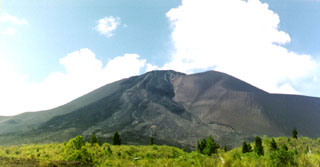Report on Soputan (Indonesia) — August 1984
Scientific Event Alert Network Bulletin, vol. 9, no. 8 (August 1984)
Managing Editor: Lindsay McClelland.
Soputan (Indonesia) Ash eruption follows local seismicity
Please cite this report as:
Global Volcanism Program, 1984. Report on Soputan (Indonesia) (McClelland, L., ed.). Scientific Event Alert Network Bulletin, 9:8. Smithsonian Institution. https://doi.org/10.5479/si.GVP.SEAN198408-266030
Soputan
Indonesia
1.112°N, 124.737°E; summit elev. 1785 m
All times are local (unless otherwise noted)
A 5-hour explosive eruption occurred at Soputan on 31 August, the first activity since the 24-26 May tephra ejection. VSI seismic instruments recorded a progressive increase in local seismicity beginning 6 August. On 14 August, a sequence of tremors appeared between 0400 and 0800, with amplitude increasing to 25 mm (at 2,000 magnification). VSI issued a warning to civil authorities and an alert was put into effect on the 14th. Seismicity continued 15-25 August with an irregular number of A-and B-type events, averaging 1-2/day. From 25 August until the time of the eruption, seismicity totally stopped, increasing suspicion among VSI scientists that an eruption was possible.
The eruption started at 0709 on 31 August and lasted until about noon. An ash column rose to ~6 km and moved NE. Authorities and area residents were well-prepared, and neither casualties nor an evacuation were reported. Press sources reported that the ash cloud could be seen from Manado, the provincial capital 5 km to the NNE. The ash cloud covered a large area and disrupted traffic on the trans-Sulawesi highway.
On 31 August at 1457, a visible-band image from the NOAA 7 polar orbiting satellite showed a plume extending ~450 km W from the volcano. The plume was quite dense and ~120 km wide.
Geological Summary. The Soputan stratovolcano on the southern rim of the Quaternary Tondano caldera on the northern arm of Sulawesi Island is one of Sulawesi's most active volcanoes. The youthful, largely unvegetated volcano is the only active cone in the Sempu-Soputan volcanic complex, which includes the Soputan caldera, Rindengan, and Manimporok (3.5 km ESE). Kawah Masem maar was formed in the W part of the caldera and contains a crater lake; sulfur has been extracted from fumarolic areas in the maar since 1938. Recent eruptions have originated at both the summit crater and Aeseput, a prominent NE-flank vent that formed in 1906 and was the source of intermittent major lava flows until 1924.
Information Contacts: A. Sudradjat, VSI; M. Matson, NOAA; UPI.

